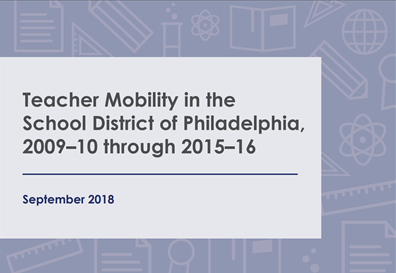By: Matthew P. Steinberg, Ruth Curran Neild, W. Kyle Canuette, Sharin Park, Emily Schulman, and Melissa Wright
September 2018
Summary
Teachers are the most important influence in schools on student achievement, which makes attracting and retaining excellent teachers a high priority for all school districts. But public schools in large cities like Philadelphia are especially challenged to provide every student with a highly-effective teacher. Teacher mobility—that is, transferring from one school to another or leaving the profession entirely—is disproportionately concentrated in urban school districts and has negative consequences for student performance. For these reasons, it is critical for policymakers and school leaders in Philadelphia to have a clear picture of the extent and nature of teacher mobility.
This study examines the number and percentage of mobile teachers in the School District of Philadelphia from 2009-10 through 2015-16. Mobile teachers are defined as those who did not return in the following year to the school where they had been teaching. The study shows the percentage of these mobile teachers who left their school for another school in SDP, exited for a Philadelphia charter school or another Pennsylvania public school outside of Philadelphia, or left Pennsylvania’s public education sector entirely. The study also presents key characteristics of mobile teachers and the schools they exited and entered.
The study uses publicly available personnel records from the Pennsylvania Department of Education (PDE) and school-level information retrieved from the U.S. Department of Education National Center for Education Statistics.
Key Findings
-
On average, 27 percent of teachers exited their schools in a given school year, either to transfer to another SDP school or to leave the district. Teacher mobility rates spiked at the end of 2010-11 and 2012-13, likely due to SDP’s Renaissance School Initiative, under which district schools were converted to charters, and staff layoffs following the district’s major round of school closings at the end of the 2012-13 school year.
-
Over half of all mobile teachers exited SDP, resulting in an average annual district departure rate of 14.6 percent. Of those who left SDP, about 10 percent taught in any Pennsylvania public school during the following school year.
-
Across all study years, 2.9 percent of teachers exited SDP for a charter school in Philadelphia. Olney Charter High School and Mastery Charter School Gratz Campus—both part of the Renaissance School Initiative—received the largest share of mobile SDP teachers who remained in Philadelphia.
-
Across all study years, 2.4 percent of teachers who exited SDP taught in a Pennsylvania public school outside of Philadelphia. Upper Darby and North Penn school districts received the largest share of mobile SDP teachers who exited Philadelphia.
-
Mobility was highest among teachers with the fewest years of experience in education and among those with the most experience. First-year teacher mobility was above 50 percent. Mobility fell sharply across the first decade of teaching, hovered around 20 percent for those with 11-28 years in education, and increased rapidly for those with 30 years or more of experience.
-
Teacher mobility affected all subjects and grade levels but teachers of mathematics, science, and English were more mobile than others. Annually, 32.6 percent of mathematics teachers exited their schools, and more than half of these teachers left SDP entirely. Science and English teachers were close behind in terms of overall mobility and district departure. Approximately 23 percent of general education teachers—those teaching a range of subjects, usually in the elementary grades—were mobile.
-
The typical mobile SDP teacher enters a school in the next year that has fewer minority students, fewer low-income students, and higher math and ELA achievement.
Policy and Implications
-
Relatively few teachers left SDP for charter schools or other public school districts in Pennsylvania—a fact that can inform the district’s policy choices related to teacher recruitment and retention. For any school district, formulating a strategy to recruit and retain teachers requires a clear understanding of the problem and a set of targeted responses. This report shows that teacher departure to Philadelphia charter schools or other Pennsylvania public schools was not a major part of SDP’s teacher recruitment and retention challenge.
-
The high percentage of departing SDP teachers who did not continue to teach in Pennsylvania public schools raises many questions about whether they planned for a short or long career in education when they began to teach in SDP. Without more information about what SDP teachers do after they leave the district or their intended length of commitment, it is difficult to formulate policy responses designed to retain them. But learning more about the individual and school factors associated with longer SDP retention—particularly for teachers with 1-3 years of experience—could inform teacher candidate selection and help refine the induction programs intended to help them succeed.
-
The high turnover among early career teachers, though not unique to Philadelphia, is an area for ongoing attention. In particular, teachers with 1-3 years of experience are over-represented among teachers who exited SDP or transferred to another SDP school. Some of this mobility may be normal and beneficial, as teachers seek school assignments that best match their skills, but some of this mobility may be the result of difficult teaching assignments or a lack of support for new teachers.

